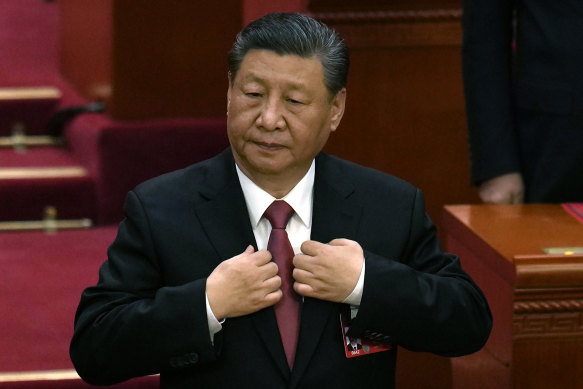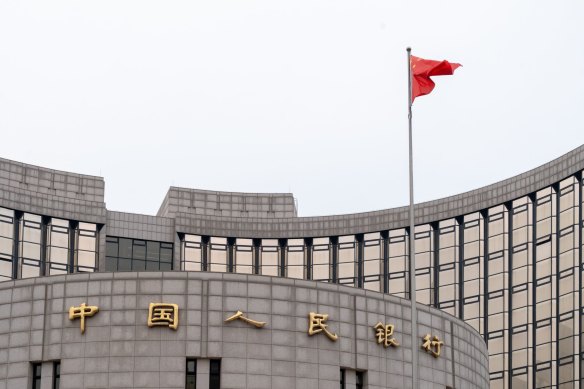This was published 4 months ago
Opinion
China’s government is MIA as central bank tries to save its economy
Stephen Bartholomeusz
Senior business columnistThe slew of stimulus measures China’s central bank unleashed on Tuesday indicates growing anxiety about the country’s deflating economy. It’s a big package, the biggest since the pandemic – but it might still not be enough to turn things around.
It’s notable that because the broad suite of policy actions was announced by the People’s Bank of China (PBOC), they’re all just monetary policy measures.
Notably missing, so far, is the fiscal policy stimulus from the central government that Western economists have been calling for ever since China’s property crisis began developing four years ago.

President Xi Jinping needs to step in to save China’s economy from falling into a deflationary spiral. Credit: AP
That may yet come, although Xi Jinping’s reluctance to inject cash directly into households to boost consumption – he believes people should work for a living rather than receive government handouts – would have to be overcome if the remedy Western governments would choose in China’s circumstances is to be deployed.
In that sense, the moves by the PBOC are half-measures. They might help the economy at the margin, but they aren’t a solution to its structural challenges.
The new-found urgency by China’s central bank – underscored by the unusual breadth of its measures and the significance attributed to them during a rare press conference – stems from a continuing stream of data showing a slowing economy and the onset of a deflationary spiral
If China can’t trade its way out of its problems, it needs to find other drivers of growth from within.
Households are deleveraging amid weakening consumer spending and confidence as property prices continue to fall. Industrial activity is shrinking and overcapacity in all but a relative handful of government-targeted strategic sectors is rising.
The country’s official economic growth target for this year of “about 5 per cent” is under threat and the plethora of modest efforts to arrest the disturbing trends this year have proven ineffective. Most Western forecasters have been downgrading their expectations for this year’s growth rate to something with a 4 in front of it as the slew of disappointing statistics keeps coming.
The PBOC’s response is to target the property and sharemarkets.
The central bank has cut its main policy rate from 1.7 per cent to 1.5 per cent and reduced the reserve requirement ratio for banks to boost liquidity therefore lending in the system by more than $200 billion while signalling a possible further cut this year. It also lowered rates on existing mortgages and cut the required mortgage down payment for second homes from 25 per cent to 15 per cent.

The new-found urgency by China’s central bank flows from the continuing flow of data highlighting the slowdown in China’s economy.Credit: Bloomberg
The PBOC will also improve the terms under which it provides finance to local government-owned entities to acquire unsold inventory held by distressed property developers, providing 100 per cent of the principal rather than the current 60 per cent.
The bank said the cut to mortgage rates was expected to benefit 50 million households and 150 million people, reducing their interest expense by about $30 billion a year.
Trying to provide a floor under the sharemarket, which has been falling for the past three and a half years – the country’s benchmark CSI 300 index is down more than 42 per cent since early 2021 – the PBOC announced a (roughly) $100 billion fund to help brokers, insurance companies and investment funds buy shares, while also providing funding to companies to finance share buybacks. Those announcements saw the CSI 300 rise more than 4 per cent.
At the heart of the economic malaise that has gripped China since the pandemic is the implosion of its property market, which has struck at the core of its middle-class households’ wealth and undermined their confidence and willingness to spend. Property prices and sales are still declining.
The PBOC’s measures – making more credit available more cheaply to households and, it hopes, injecting some liquidity and confidence into the sharemarket – use the only policy tools available to a central bank. They will only be effective if households and businesses regain confidence and stop deleveraging.
More and cheaper credit only has an effect if the demand for credit, which has been diminishing, increases again. Putting more money into household accounts by lowering mortgage rates will only be effective if those households spend it, rather than save it.
That’s why much of the external focus on China has been on the precursors for structural change – measures to stimulate confidence and consumption, changes in the fiscal relationships between Beijing and local governments and a reversal of policies (Xi’s series of industry crackdowns, the latest deep and widespread cuts to finance sector salaries) that have hurt the private sector, which historically has generated a disproportionate share of China’s growth.

At the heart of the economic malaise that has gripped China since the pandemic is the implosion of its property market.Credit: AP
The pressure to do more than ease monetary policy is rising, given the mounting pushback from China’s trade partners against the flood of cheap exports driven by the weakness of its domestic demand.
Beijing will also be mindful of the threat of a Donald Trump return to the White House and his fixation with tariffs. He has promised a baseline tariff on all imports to the US between 10 and 20 per cent, and a 60 per cent duty on imports from China.
Even if Kamala Harris were to prevail in the November election, protectionist sentiment in the US has broadly become entrenched across party lines.
In Europe, too, policymakers are moving to protect their industries from China’s exports with tariffs and quotas of their own.
That’s why the missing pieces of China’s response to its misfiring economy and the growing threat of deflation are major fiscal stimulus and policy reforms. If China can’t trade its way out of its problems, it needs to find other drivers of growth from within.
It needs to clear the massive overhang of unsold and unfinished homes, which will be painful and costly, restructure the funding and funding arrangements of the local governments implementing Beijing’s policies, deliver social welfare and services, and restore confidence – and some freedoms – to its entrepreneurial private sector.
The PBOC has done its bit and has made it clear that it will continue to do what it can.
If China is to avoid a descent into entrenched deflation and economic stagnation, Xi and his party need to do their bit – a potentially much more impactful bit.
The Business Briefing newsletter delivers major stories, exclusive coverage and expert opinion. Sign up to get it every weekday morning.